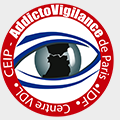
2ème Congrès Européen – EMCDDA 2017
“Chemsex” means sex, generally between men, occurring under the influence of drugs taken immediately before and/or during the sexual session. “Slam” is defined by injection of psychostimulant drugs in the same context. Such phenomena have particularly increased with the emergence of the new psychoactive substances (NPS) on the drug market. Available on the Internet, renowned as pure, their users were unaware of their toxic and addictive potential. Moreover, chemsexers didn’t consider the risk of their practice, didn’t identify with usual drug addicts and they had difficulties turning to centers dedicated to drug users.

The Parisian Addictovigilance center presents preliminary results of a specific harm reduction program for slammers and chemsexers, based on the toxicological analysis of NPS.

Study was built by stages
(1) Questionnaire of evaluation on chemsex practice and collection of samples
(2) Toxicological analysis of collected drugs
(3) Communication of results during Focus Groups with impact assessment according to two different scales

RESULTS
From January 2016 to January 2017, 30 questionnaires on chemsex practice were completed, 53 samples were analyzed and 30 completed questionnaires on harm risk reduction were collected.
Stage 1: 18/30 of participants were slammers. Motivations for chemsex were mainly disinhibition and seeking pleasure (19 mentions each) or prolonging pleasure (13 mentions). They obtained their products by the Internet (17 by referenced website and 1 by the darknet), 8 gifts and 4 deals.
Stage 2: Collected samples were presented as cathinones (alpha-PVP, 4F-PVP, PVP-8, 3-MMC, 2-MMC, 4-MEC, methylone, MDPV), other phenethylamines (2-FMA, methamphetamine, 3,4-CTMP, 3-FPM) and cocaine. Analytical results by liquid chromatography with high resolution mass spectrometry detection show a 85% adequacy between the announced substance and the identified molecule. Moreover, variability of purity is high and concentrations varied greatly as underlined with 4-MEC (min: 13 % – max: 100 %) or 3-MMC (min: 11 % – max: 88 %).
Stage 3: The Focus Group session revealed an impact assessment in mind of chemsexers. Concerning their opinion of the analysis of psychoactive substances, 19 had a positive changing at the end of the Focus Group with an average of +2.4 points. Their level of knowledge on the products and harm reduction questionnaire was relatively good: 8.79 on a scale of 12 items at the beginning of the session and a final level of knowledge at 9.75/12 at the end of the Focus group.
This study is still ongoing and the final results should allow the implementation in routine practice of a validated approach of harm reduction in this specific population.

![]()
![]()
![]()
Contact
Email: ceip.addictovigilance-paris.lrb@aphp.fr
Phone number: +33 (0)1 40 05 42 70
Adress: Hôpital Fernand Widal, CEIP – Addictovigilance, 200 rue du faubourg Saint Denis – 75010 PARIS

